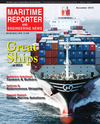
Page 27: of Maritime Reporter Magazine (December 2015)
Great Ships of 2015
Read this page in Pdf, Flash or Html5 edition of December 2015 Maritime Reporter Magazine
number of simulations. A variety of end of the simulation. The maximum from the technical point of view, but ing a reality, and even though some different ship types and sizes need to power used for this second example from the business point of view as well. problems may still be time-consuming be tested over a range of weather con- might be considered close to the mini- It enables a proactive approach to solv- (e.g. maneuvering in a seaway), CFD ditions. In each case a range of power mum safe amount. ing client problems, and provides the can be expected to play an increasingly settings have to be applied to identify means to revolutionize a maritime in- prominent role in the marine and off- the point at which a vessel can no longer Summary dustry that is traditionally evolutionary shore business sectors. maneuver in the prescribed weather con- CFD has become a practical tool in al- in nature. dition. The approach is demonstrated us- ing a generic Very Large Crude Carrier (VLCC) trying to turn in 5.5 meter beam seas and 37 knots of side wind. Figure 6 shows the overset grid in a large back- ground earth-? xed domain with a total of 7M trimmed hexahedral cells. The simulation starts with the ship at low speed and straight rudder to build fully- developed Kelvin and viscous wakes.
The vessel is free to move in six degrees- of-freedom so the effects of added resis- tance and lost propulsive ef? ciency are included. Once the wakes are developed (and propeller forces stabilized), the rud- der is put over 20 degrees and the power increased to full.
Simulations are conducted at differ- ent power levels under both full load and ballast draft conditions. If the prescribed maximum power is acceptable, the ves- sel accelerates under the in? uence of its own propulsive and rudder forces. At power levels below some point the ship can no longer overcome forces and mo- ments imposed by the wind and waves, and just blows sideways. Figure 7 shows an example where the power is suf? cient for a complete turn, whereas Figure 8 shows the trajectory from a vessel with lower maximum power. Note that in
Figure 8 the vessel is seen to drift three- quarters of a boat length to leeward be- fore starting to recover distance back to windward. The small high speed oscilla- tions superimposed on top of the curves are due to vessel motions over individual waves. It is interesting that even though the turn rate (yaw angle versus time) be- comes steady about half way through the simulation, the vessel is only just man- aging to halt its slide to leeward near the most every sense. This is true not just Design optimization is ? nally becom-
The Author
Dr. Richard Korpus is Chief Scientist for the American Bureau of Shipping (ABS), where he is responsible for integra- tion and quality control of CFD services worldwide. Since joining ABS in 2013,
Dr. Korpus has matured CFD into an es- sential part of ABS’ technology offerings, and developed new client services to ensure ABS remains ahead of the com- petition. CFD is now used over a wide range of marine and offshore applica- tions to support customer requests to increase operating ef? ciency, enhance environmental performance, and im- prove safety.. www.marinelink.com 27
MR #12 (26-33).indd 27 12/4/2015 2:24:42 PM

 26
26

 28
28
